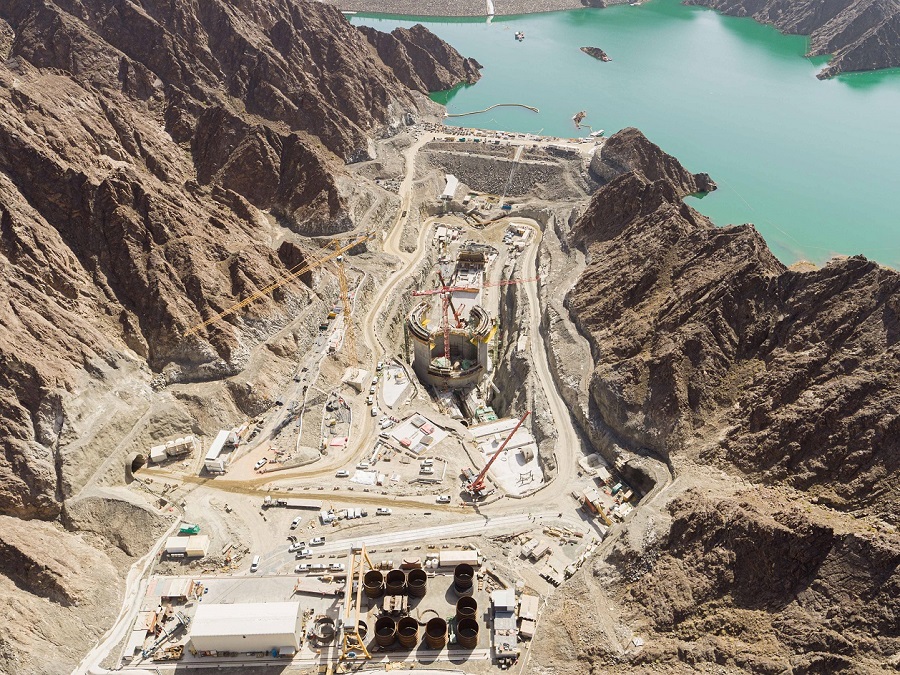Dubai Electricity and Water Authority (DEWA) has completed 44% of its pumped-storage hydroelectric power station in Hatta, considered to be the first station of its kind in the GCC. The plant will have a production capacity of 250MW, a storage capacity of 1,500MWh and a life span of up to 80 years.
With investments of up to $386.8mn, the hydroelectric power plant in Hatta is part of DEWA’s efforts to achieve the vision and directives of His Highness Sheikh Mohammed bin Rashid Al Maktoum, Vice President and Prime Minister of the UAE and Ruler of Dubai.
The plant also supports the Hatta Development Plan launched by the Dubai Ruler.
The project update was announced during DEWA’s MD and CEO Saeed Mohammed Al Tayer‘s visit to the construction site, to review its progress. He was briefed on the project’s progress, and also inspected the construction of the power generators and the upper dam, whose first 37m high roller-compacted concrete wall has been completed.
DEWA noted that work is currently underway on the 70m main dam wall. The station will use the water from the Hatta Dam and an upper dam being built in the mountain.
Al Tayer also reviewed the progress of the 1.2km subterranean tunnel, which will connect the two dams.
The hydroelectric power plant is an energy storage that utilises the potential energy of the water stored in the upper dam which is converted to kinetic energy during the flow of water through the subterranean tunnel and this kinetic energy rotates the turbines and converts mechanical energy to electrical energy which is sent to DEWA’s grid.
Then to store energy again, clean energy generated at the Mohammed bin Rashid Al Maktoum Solar Park is used to pump the water through this tunnel back from Hatta dam to the upper dam by converting the electrical energy to kinetic energy and then finally storing it as a potential energy in the upper dam.
The power plant will have turnaround efficiency of 78.9 percent and response to demand for energy within 90 seconds.

Hatta Development Plan
The Hatta Development Plan includes the establishment of a 5.4km long cable car route and the Dubai Mountain Peak at an altitude of 1,300m (the summit of Jebel Umm Al Nisour), Hatta Sustainable Waterfalls to contribute to the overall development of the Hatta region and provide innovative job opportunities for its citizens.
DEWA’s projects are expected to provide around 200 technical, administrative and operational jobs in Hatta. Another 300 jobs are expected to be created by the Visitor Centre, and other outdoor activities and tourist facilities associated with the project.
Al Tayer also noted that with the development of the plant, DEWA aims to achieve comprehensive and sustainable development and diversify the clean and renewable energy sources in Dubai to achieve Dubai Clean Energy Strategy 2050 and Net Zero Carbon Emissions Strategy 2050 to provide 100% of Dubai’s total power capacity from clean energy sources by 2050. This includes all available technologies such as photovoltaic solar panels, Concentrated Solar Power (CSP), and green hydrogen production using renewable energy.
In relation to this, the construction of the hydroelectric power plant uses the latest and safest drilling technologies suited to Hatta’s geological features. It adheres to the strictest international environmental standards to protect the Hatta Natural Reserve.


Dubai Mountain Peak development
During the visit, Al Tayer was briefed by the project manager on the developments of other related projects such as the ‘Dubai Mountain Peak’ and the ‘Hatta Sustainable Waterfalls’ project, which DEWA has tendered.
The projects will contribute to the overall development in the Hatta region, especially the Dubai Mountain Peak, which includes the construction of a 5.4km cable car to transport tourists to the summit of Um Al Nesoor.
At 1,300m above sea level, it is the highest natural summit in Dubai. The cable car route passes over the Hatta Dam lake and the upper dam lake, which are parts of the Hatta pumped-storage hydroelectricity plant currently under construction, as well as over the mountains. The route ends at the summit of the Um Al Nesoor mountain.
Al Tayer also reviewed the progress of the Hatta Sustainable Waterfalls project. The project will use the slope of Hatta dam to create a natural waterfall. A waterway will be built along the parking area below the dam. The water used in the waterfall will be collected at the end of the stream, recycled, and pumped back to the top of the dam. The area will be developed to create recreational spaces and restaurants.





